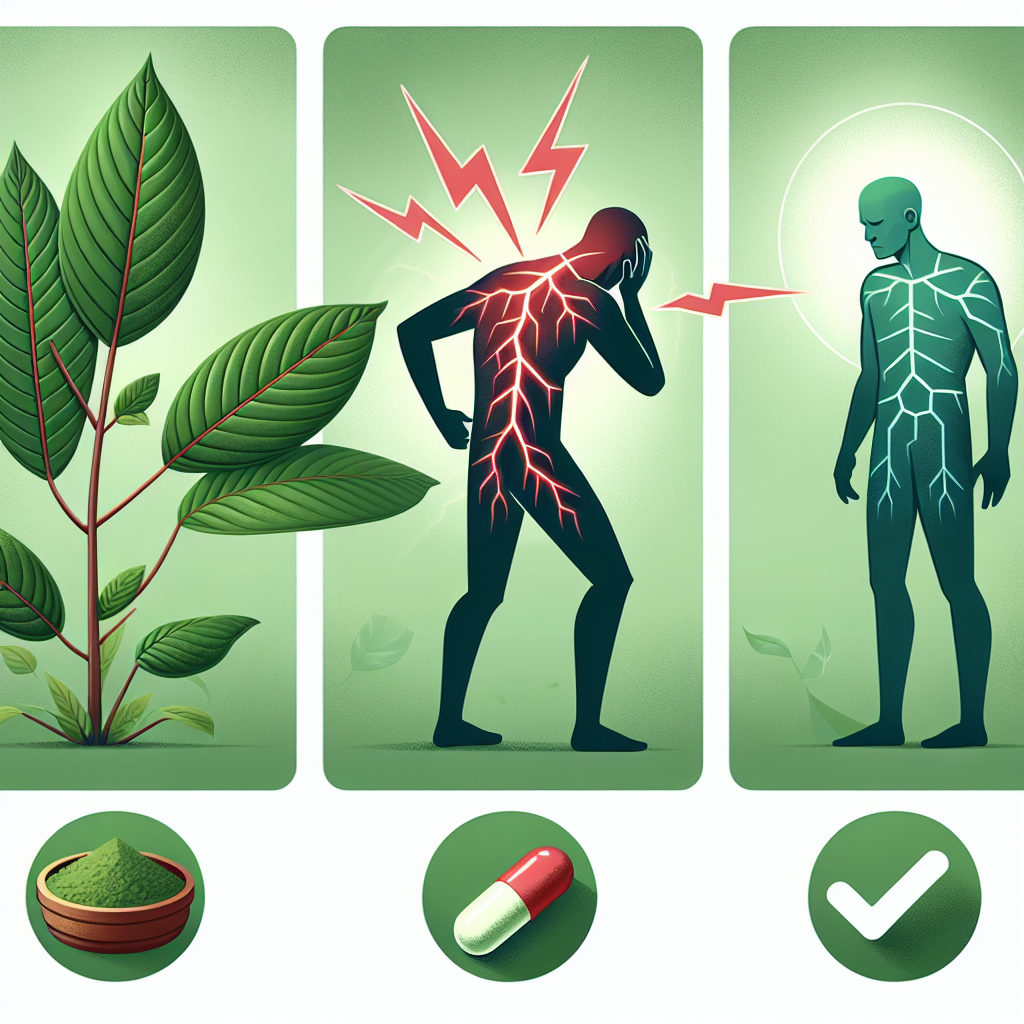- Understanding Kratom and its active compounds
- Kratom’s efficacy in pain relief: An overview
- Potential risks and side effects of Kratom use
- Kratom compared to traditional pain medications
- Frequently asked questions about Kratom
 Kratom, a tropical tree native to Southeast Asia, has been historically used in its native regions for its psychoactive properties. Today, as the world shifts towards >>non-prescription pain relief<>opioid alternative<< for those seeking respite from chronic pain.
Kratom, a tropical tree native to Southeast Asia, has been historically used in its native regions for its psychoactive properties. Today, as the world shifts towards >>non-prescription pain relief<>opioid alternative<< for those seeking respite from chronic pain.
The delicate interplay of kratom’s alkaloids can vary significantly depending on the strain and the region it's grown in. For example, the red vein kratom varieties are often associated with analgesic and sedative effects, while white vein strains might offer more energizing effects. The green vein strains could be viewed as a balance between the red and white types, providing pain relief without as much sedation. This range suggests that different strains of kratom can be selected to manage different types of pain and levels of required alertness during the day.
When considering kratom use for pain management, it is essential to understand that the alkaloid concentration can vary not only between different types of kratom but even within the same strain, due to changes in agricultural conditions. Users often turn to digital scales to ensure accurate dosing, a critical measure when utilizing kratom for therapeutic purposes. Over at the digital scales category, individuals aiming for precision can find a variety of tools to help measure their dosages.
Kratom is consumed in various forms, some of the most common being powders, capsules, extracts, and teas. Consumers choose the method that best fits their lifestyle and pain management needs. The Kratom shop page offers an extensive selection of these products, allowing for a personalized approach to kratom use.
Now, key point focuses we must consider with kratom include:
- Variety of Strains: There are numerous kratom strains, each with distinct profiles of alkaloids, which might affect their effectiveness in pain relief.
- Method of Consumption: Kratom can be ingested via capsules, powder, or as a tea. Each method changes the rate of absorption and the duration of effects.
- Alkaloid Content: It’s important to acknowledge the variability of alkaloid content within kratom, which directly impacts its efficacy and potential side effects.
Diving deeper into kratom’s active compounds, it is mitragynine that plays a pivotal role in kratom’s pain-relieving qualities. Mitragynine principally binds to mu-opioid receptors, which are the same receptors that are activated by prescription opioids. However, it’s crucial to delineate that while they may target similar receptors, the interaction of kratom alkaloids with these receptors is different, often leading to fewer side effects compared to conventional opioids.
| Alkaloid | Effects |
|---|---|
| Mitragynine | Pain relief, mild stimulation |
| 7-hydroxymitragynine | Increased pain relief, sedation |
| Speciociliatine | Mild opioid receptor agonist |
Research continues to delve into the specifics of how these alkaloids contribute to pain relief and what dosage would be optimal for analgesic effects without leading to dependency or abuse. Notably, higher doses of kratom can induce more profound sedative effects, which might be beneficial for severe pain but could also increase the risk of side effects and tolerance.
Furthermore, combining the knowledge of kratom’s active compounds with a balanced look into its potential as a natural pain management system, it becomes clear that while it holds promise, there is also a great need for standardized regulation and comprehensive research to understand its long-term effects.
Kratom’s efficacy in pain relief: An overview
As we explore kratom’s potential in non-prescription pain relief, it’s important to examine the claims made by individuals who have found it to be an efficient means of managing pain naturally. Anecdotal evidence suggests that kratom may offer a level of pain management akin to that of over-the-counter medications and, in some cases, even prescription painkillers. Although scientific research is still catching up to these personal accounts, the interest in kratom as an opioid alternative is steadily increasing.
Kratom use for pain management is a subject of particular significance given the current opioid crisis. With a growing number of individuals searching for alternatives to prescription painkillers, which are often associated with a risk of addiction and overdose, kratom presents an intriguing option. It is touted for its ability to potentially reduce pain while also offering a smaller window for abuse, mainly due to its complex alkaloid profile, which varies significantly from conventional opioids.
Users who turn to kratom for pain relief often report a significant reduction in discomfort, which can be seen across various types of pain – from neuropathic pain to inflammatory and muscle pain. The type of kratom chosen will likely depend on both the severity of the pain being felt and the desired secondary effects. Those seeking full-body relief from more severe pain may gravitate towards red vein kratom powder, celebrated for its profound analgesic properties. The soporific effects, however, might make daytime activities challenging.
For users requiring a middle ground, green vein varieties offer an equilibrium between pain relief and alertness, making them suitable for use throughout the day. These options highlight kratom’s flexibility and capacity to cater to different needs without steering individuals towards the strong sedative effects typical of many prescription painkillers.
| Strain | Pain Relief Level | Typical Use |
|---|---|---|
| Red Vein | High | Nighttime/Severe Pain |
| Green Vein | Moderate | Daytime/Moderate Pain |
| White Vein | Milder | Daytime/Light Pain & Energy |
The mode of consumption also plays a role in kratom’s analgesic efficacy. Kratom capsules offer a convenient and discrete method of intake with predetermined dosages, thereby mitigating the risk of overconsumption. While some users prefer the immediate onset offered by kratom powders, others may find the more gradual release of capsules to be more suitable for sustained pain relief throughout the day.
It’s imperative to approach kratom use with a cautious and informed mindset. The variability in strength and effects seen in different kratom strains, and even within the same strain due to environmental factors, necessitates a nuanced approach to dosing. Educating oneself on the various strains, consumption methods, and dosage guidance is key for anyone considering kratom for pain management. This careful consideration ensures that the individual can maximize the plant’s analgesic potential while minimizing potential risks.
By focusing on a responsible and tailored approach to kratom use, individuals looking for alternatives in pain management can navigate the myriad of options available. And while the discourse around its effectiveness continues, there’s a growing consensus that with the right oversight, kratom may indeed carve out a legitimate space within the realm of pain management solutions.
Potential risks and side effects of Kratom use
While kratom has garnered attention for its holistic approach to managing pain naturally, it’s our responsibility to discuss the potential risks and side effects of its use. Being informed is vital as kratom is not regulated by the FDA, and thus the quality, strength, and purity of products may vary. Users should exercise caution and be aware of the possible negative implications of incorporating kratom into their pain management regimen.
The most common side effects reported by kratom users include nausea, constipation, and headaches. These are generally considered mild and often resolve on their own. However, more serious side effects can occur, especially with higher dosages or prolonged use. These may include dizziness, dry mouth, and increased urination.
Prolonged kratom use has been associated with cases of dependency and withdrawal symptoms, mirroring some opioid-like effects. The symptoms of kratom withdrawal can include muscle aches, irritability, emotional changes, and insomnia. It’s worth noting that the likelihood and severity of dependency can vary widely among individuals, with some experiencing minimal issues, while others may find cessation of use challenging.
There are also specific groups of individuals for whom kratom use might pose higher risks. Pregnant or breastfeeding women are advised against using kratom, as there is insufficient research on how it may affect fetal development or infant health. Similarly, individuals with liver disease, a history of substance abuse, or those taking certain medications should consult with a healthcare provider before considering kratom use.
Given its potent effects on the body’s systems, interactions with other drugs may occur. Kratom may potentially increase the risks when taken in conjunction with sedatives, CNS depressants, or other substances that affect the opioid receptors. Therefore, it is crucial to discuss kratom use with a healthcare professional if other medications are being taken, to ensure safe use.
| Potential Risk | Side Effect |
|---|---|
| Dependency | Withdrawal symptoms upon cessation |
| Interaction with Medication | Heightened risk when combined with certain drugs |
| Prolonged High-dose Use | Liver toxicity, severe constipation, respiratory issues |
An emerging concern in the medical community is the lack of standardized dosing and product quality due to the non-prescription status of kratom. Factors like the source of the kratom, the method of ingestion, and individual biology can heavily influence the effects, making it challenging to establish universal dosing guidelines or a clear risk profile. This emphasizes the importance of sourcing products from reputable vendors, such as those found on the Kratom shop page, where quality and customer reviews can guide informed choices.
It’s important to highlight that while kratom may be promoted as an opioid alternative, it is not a substance that comes without risks, and its legal status varies by country and even by state within the United States. Users considering kratom for non-prescription pain relief should stay informed about the legality and regulatory status in their region, as well as being aware of the potential side effects and risks associated with its use. As with any supplement, particularly those that act on the opioid receptors, responsible and educated use is key to minimizing unwanted outcomes.
Kratom compared to traditional pain medications
 When juxtaposed with traditional pain medications, kratom presents a different side of the spectrum in terms of access, risk, and mechanism of action. Conventional pain medications, classified into nonsteroidal anti-inflammatory drugs (NSAIDs), acetaminophen, and opioids, have been extensively used and studied. NSAIDs and acetaminophen are readily available over-the-counter and are effective for mild to moderate pain, but they also bear risks such as gastrointestinal bleeding, liver damage, and the potential for cardiovascular issues with prolonged use. Prescription opioids, while potent in managing severe pain, have contributed to the current crisis due to their high potential for dependence and overdose.
When juxtaposed with traditional pain medications, kratom presents a different side of the spectrum in terms of access, risk, and mechanism of action. Conventional pain medications, classified into nonsteroidal anti-inflammatory drugs (NSAIDs), acetaminophen, and opioids, have been extensively used and studied. NSAIDs and acetaminophen are readily available over-the-counter and are effective for mild to moderate pain, but they also bear risks such as gastrointestinal bleeding, liver damage, and the potential for cardiovascular issues with prolonged use. Prescription opioids, while potent in managing severe pain, have contributed to the current crisis due to their high potential for dependence and overdose.
Kratom, alternatively touted as a non-prescription pain relief option, avails itself to users with a different profile. For one, it does not fit neatly into the categories of over-the-counter or prescription medications, occupying a grey area that confers both opportunities and challenges. Being a natural product with opioid-like effects, kratom is framed by users and some researchers as an opioid alternative, with the argument that it may induce less severe side effects and carry a lower risk of addiction. However, without FDA regulation, the consistency of the product and the accuracy of dosing are often in question.
One of the unique aspects of managing pain naturally with kratom is the method by which its users can adjust their intake to manage their pain levels. For instance, a user might start their day with a white vein kratom powder for mild pain and focus, and then switch to a red vein kratom in the evening, where relaxation and stronger pain relief are desired. This flexibility and individualized approach contrast strongly with the more rigid prescriptions typical of pharmaceutical painkillers.
Nevertheless, the stigma associated with kratom’s use and legal challenges in various jurisdictions poses barriers not seen with traditional medications. Entities like the DEA have expressed concern over kratom’s safety profile, while advocacy groups argue for its potential benefits and ask for regulation instead of outright bans. This contention dictates a cautious approach when considering kratom use, making it essential that potential users consult with healthcare professionals before starting kratom for pain management.
| Pain Relief Option | Accessibility | Risk of Dependence | Regulation | Severity of Side Effects |
|---|---|---|---|---|
| Traditional Medications (NSAIDs, Opioids) | Prescription & OTC | Variable to High (esp. opioids) | FDA-Regulated | Low to High |
| Kratom | Non-prescription | Reportedly Lower than Opioids | Not FDA-Regulated | Reportedly Mild to Moderate |
The accessibility of kratom further enhances its appeal, with a plethora of options available online for those seeking alternatives to traditional medications. Platforms such as Kratom shop page, offer various forms from powders to capsules, extracts, and teas, allowing users to choose how they prefer to consume kratom. This wide range of product forms is not typically found with prescription pain medications, which are usually limited to tablets, patches, or injectables.
In conclusion, although kratom is recognized by many of its users as a viable method for managing pain naturally, it is crucial to consider the legal, quality, and health-related aspects before integrating it into one’s pain management plan. Its comparison to traditional pain medications is nuanced, encompassing factors like non-prescription status, reduced risk of dependence as reported by users, and the current lack of regulatory oversight. The ongoing debate and research into kratom’s safety, efficacy, and potential risks will continue to shape its role in the evolving landscape of pain management solutions.
Frequently asked questions about Kratom
As interest in kratom surges, questions about its role as a non-prescription pain relief option naturally arise. Users and onlookers alike have queries regarding the efficacy, safety, and best practices of using this plant. Below, we present answers to some of the most common questions, aiming to demystify kratom’s nature and use.
Frequently Asked Questions about Kratom
- Is kratom legal?
- Kratom’s legal status varies by country and within countries. In the United States, for instance, it’s federally legal but banned or regulated in some states. It’s crucial to check the local laws applicable to your area before purchasing or using kratom.
- How does kratom relieve pain?
- Kratom contains alkaloids like mitragynine that interact with opioid receptors in the brain, providing analgesic effects. Users often report relief from various types of pain when using kratom, making it an intriguing opioid alternative for managing pain naturally.
- What are the recommended dosages for pain relief?
- Due to the lack of FDA regulation, there are no standardized dosages for kratom. Dosage can depend on factors like body weight, tolerance, and the type of pain. Beginners are advised to start with a small amount (1-2 grams) and gradually increase it as necessary, monitoring their body’s response.
- Can kratom be used along with other pain medications?
- Kratom can interact with other medications, particularly those that are also metabolized by the liver or affect the opioid receptors. If you’re considering kratom use while on other medications, consult a healthcare professional to mitigate risks of harmful interactions or side effects.
- What are the side effects of using kratom?
- Common side effects include nausea, constipation, dry mouth, and headaches. More serious side effects might arise from high dosages or long-term use, such as dependency, liver toxicity, or withdrawal symptoms. Responsible use and moderation are key.
Remember, while kratom has potential as a non-prescription pain relief alternative, it’s not without risks. Before starting kratom, it’s advisable to conduct thorough research and consult with a healthcare provider, especially if you have any existing health conditions or are taking other medications. For those interested in exploring the different strains and forms of kratom, visiting Kratom shop page can provide a broad range of options, from powders to capsules and extracts. Each product comes with user reviews and detailed descriptions to guide informed decisions. Additionally, for those seeking in-depth information on kratom’s impact on pain, the various strains, and their specific effects, our platform offers a wealth of educational resources to support your journey in managing pain naturally with kratom.









